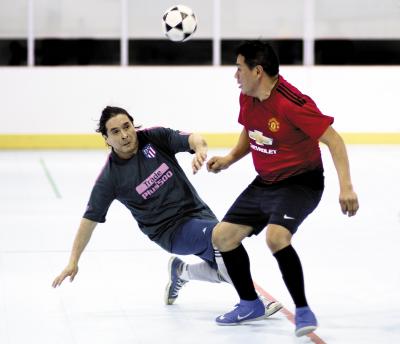Indoor Soccer as a Touchstone

The drive north on Abraham’s Path in Amagansett is dark and nearly absent of cars this time of winter, even on a weekend night, until you near the intersection of Town Lane and see the lights from the multi-use Sportime Arena glowing in the distance off to the right, along with the swaying headlights of cars pulling into the parking lot, and the silhouettes of soccer players and their families hustling toward the front doors.
Once inside, the smell of empanadas and home-cooked spare ribs wafts from the snack bar and bleachers area, and the sound of animated Spanish being spoken by players yelling to one another for the ball echoes in the hangar-like building. The 85-by-200-foot multipurpose floor (which can also be converted into a hockey rink) is ringed by waist-high wood boards topped by plexiglass panels and set up for indoor soccer with a net at either end. Latin music is usually playing over the sound system.
Ninety-nine percent of the players in the fall and winter nine-week tournament leagues — or torneos — are Latino, said Ramon Nuala, who has served as the league’s director since its inception seven years ago. But 100 percent of the people in the building seem to love what they find here on weekends. It’s a community gathering spot and cultural touchstone as much as a sporting event.
The 7-on-7 games in the men and women’s open divisions and over-37 leagues are part of the draw. But so is the chance for so many families to gather in one place, renew acquaintances, and channel a bit of their heritage even if they themselves were born in the U.S. There are 42 teams in all, and many of them choose Spanish-inflected names like Liga S.B. (S.B. for the Ecuadorean village of San Bartolo) or the men’s team Su Madre, which is Spanish for “Your Mother” but not to be confused with the trash-talking English expression “Yo Mama.”
“No, no, no,” Kimberly Bautista, a Sportime employee who was working the scoreboard Friday night, said, laughing. “It’s a respectful way of saying ‘Your Mothers.’ We have a Los Papis team too.”
The 45-minute games roll out every hour on the hour from 6 to 11 p.m. on Fridays and Saturdays, and 1 to 10 p.m. on Sundays. Nuala says it’s not uncommon for one family to have the wife playing in one game, her husband playing in another, and their children playing on a team or sitting in the stands, watching the games.
(During the week, Sportime hosts wintertime Soccer Stars NY age-group clinics and play for kids run by Martin Gutierrez, a UEFA and FIFA-licensed coach who played three years for the New York Red Bulls and has coached pro teams as far away as China. Twelve boys Gutierrez has coached now play for the East Hampton High School boys team. Friday night, he was at Sportime refereeing some of the games.)
Nuala says he and the Sportime staff try to keep the atmosphere of the torneos respectful. But that’s different from saying the level of play isn’t occasionally intense — it is — or that the competition for players isn’t heated.
Among the men’s teams, in particular, it isn’t uncommon for team managers to recruit players, and throw in incentives like offering to pay for a player’s league registration and uniform fees, which can easily run more than $200 per torneo. Some players commute from as far away as Bay Shore, Patchogue, even New York City.
At the end of every nine-week cycle, there’s a championship round that attracts a near-capacity crowd. Afterward, a ceremony is held and trophies are awarded.
“You should be here then — the atmosphere for the playoffs is really great,” said Tyler Jarvis, who manages the Sportime Arena. “We have people chanting for the players and teams, yelling at the refs. It gets pretty loud and intense.”
To keep the ball inbounds more since the rink boards are out of play, a less inflated soccer ball that’s four inches smaller in diameter than a regulation 28-inch outdoor ball is used. Though the indoor ball has less bounce, the level of play is good. Most of the Sportime players seem to have little trouble shooting, passing, or even heading the ball. They just adjust their games, if not their expectations.
Andres Meija, a 38-year-old truck driver from East Hampton who plays striker for the Le Calle team, said his soccer favorites are two of the world’s greats, Lionel Messi and Ronaldo. Meija was named most valuable player in the recent men’s over-37 playoffs.
“I’m here because I’ve loved soccer my whole life,” he said.
Though the Liga S.B. men’s and women’s teams dominated play for many years, the mix of torneo winners has recently changed. In six weeks, Nuala said, new champions will again be crowned before the games move back outside, and winter once again gives way to spring.
